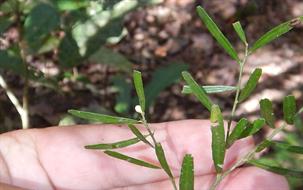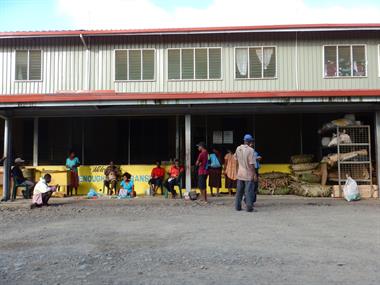.
Wednesday, 8th October.
A morning looking for plants.
We begin by coming across some strange lianas.
A morning looking for plants.
We begin by coming across some strange lianas.
Then we spotted an area where there were loads of C. wintersii. The ground is covered with seedlings.
A Citrus wintersii plant 3 metres tall. Such a tall example has never been reported before.
In this picture there are countless plants and fruits.
Then we find a flower. My fingers give an idea of the size.
And another one.
Then a near-citrus bearing ripe, red fruit emitting a drop of gum. This fruit contained four seeds which have all germinated.
All photos can be clicked to enlarge!
Thursday, 9th October.
I have enough seeds of C. wintersii. I want to take them to the university but before that I have a meal.
Kangaroos can't win every time. This one has lost.
I have enough seeds of C. wintersii. I want to take them to the university but before that I have a meal.
Kangaroos can't win every time. This one has lost.
Another thing I want to do before leaving is to visit the dormitory of the "flying foxes", the giant fruit-eating bats. Every night they made a great hullabaloo in the tree under which I slept. I want revenge!!
They roost in two large trees on the other side of the river. The conditions for photography are the worst you'll ever meet. The trees are very tall so I have to use the zoom. It has branches in the foreground that upset the focus, and the contrast between the sky and the bat is such that I have to overexpose the pictures to be able to make out the bats. In addition, I must not make any noise or sudden movements. So be lenient ...
They roost in two large trees on the other side of the river. The conditions for photography are the worst you'll ever meet. The trees are very tall so I have to use the zoom. It has branches in the foreground that upset the focus, and the contrast between the sky and the bat is such that I have to overexpose the pictures to be able to make out the bats. In addition, I must not make any noise or sudden movements. So be lenient ...
Click the photo for more of Sylvains bat pictures.
Now I go to Port Moresby to drop the seeds in the botany lab of the University. They will grow plants for Nathalie & SIL and I will go to the Sédé family. Tomorrow I fly to Alotau.
Friday, 10th October.
A night at the university and then I leave to take the plane to Alotau. Here's some decoration hanging on the rear-view mirror of a PMV.
A night at the university and then I leave to take the plane to Alotau. Here's some decoration hanging on the rear-view mirror of a PMV.
My intention had been to seek C. warburgiana around the Alotau Bay and in the mountains, and take the opportunity to do some underwater photography because Milne Bay is world famous for its coral reefs.
Then finally to go to Goodenough Island in search of Citrus wakonai just before leaving.
On the advice of Seb (a friend back in France), I decided to reverse the order and go as soon as possible to Goodenough. This choice may have been a good idea, as the following will show.
Having arrived in Alotau, I hitched a ride from the airport to the city. I immediately met two very nice Chinese who owned a department store in the city. They introduced me to their neighbour, a cargo-transit agent who dealt with movements in the port. He told me that one could wait ten days without a boat to Goodenough, but that a departure is scheduled this weekend. He shows me a place to sleep, the Transit Hotel. I am reluctant because usually I do not pay to sleep, but I'll see.
Then finally to go to Goodenough Island in search of Citrus wakonai just before leaving.
On the advice of Seb (a friend back in France), I decided to reverse the order and go as soon as possible to Goodenough. This choice may have been a good idea, as the following will show.
Having arrived in Alotau, I hitched a ride from the airport to the city. I immediately met two very nice Chinese who owned a department store in the city. They introduced me to their neighbour, a cargo-transit agent who dealt with movements in the port. He told me that one could wait ten days without a boat to Goodenough, but that a departure is scheduled this weekend. He shows me a place to sleep, the Transit Hotel. I am reluctant because usually I do not pay to sleep, but I'll see.
This is a building divided into 16 parts corresponding to 16 LLGs (Local Level Government). Each corresponds to one or more dependent islands of Alotau. This is not really a hotel but a local transit station between the islands and Alotau for goods and people. This is a very good idea. This type of project and organization is unfortunately often lacking in PNG.
It's a very nice and convenient way to get aquainted with the people of Goodenough. I installed myself there, and come back there every time I am in Alotau. The building consists of a screened porch where most people sleep; a room on the ground floor consisting of a dormitory, two showers and toilets; and upstairs a large dormitory and four single bedrooms. Except in the bedrooms, everyone sleeps on the floor. I sleep in the dormitory upstairs.
This is the part of the building allocated to Goodenough Island.
Saturday, 11th October.
I have found a boat to Goodenough which leaves this afternoon. Arrives tomorrow morning at dawn.
I have found a boat to Goodenough which leaves this afternoon. Arrives tomorrow morning at dawn.
I take the opportunity to visit Alotau. Here everything is different from the rest of PNG. People are smiling and friendly. Violence seems absent. For example, people walk the streets late into the night, which is unimaginable in Port Moresby and in other major cities. It's like summer in the south of France or Spain. Everyone is laughing, flirting, joking. I've never seen anything similar except at the university. The city is very clean and on a human scale. And best of all, there are no mosquitoes.
There are three covered markets. This one is right next to the transit hotel, and this is where I eat.
From the quays I took some photos into the harbour water.
Click image for more of Sylvain's sea-floor photos!
.
They are also seen in North Queensland. The plants must be very old, as it is thought the vine has climbed up a sapling by winding itself around. This was so long ago that the host sapling is long dead and rotted away, leaving the twisted vine to keep growing in the same shape.
An Australian contact comments about these lianas:
Megapodes eggs are very expensive, 5 kina, equivalent to € 1.50.
In PNG, everything is very expensive.
In PNG, everything is very expensive.
Megapodes eggs are very similar to duck eggs, considerably larger than hens eggs and with a stronger taste.
Here's our boat. This is the MV Goodenough II.
Just next door is the MV Goodenough I. The same boat Helena travelled on when she came here:
See the remarkable story of student nurse Helena who worked on Goodenough Island in 2012.
Click Here.
Click Here.
Loading the boat.
7pm and still not departed. Now they talk about 8pm or 9pm. We'll see ...
7pm and still not departed. Now they talk about 8pm or 9pm. We'll see ...
At 9:36pm we leave for Goodenough Island. A 12-hour journey.This is what it's like onboard.
The Quest for Wakonai!
part 15 of Sylvain's adventures in Papua New Guinea
part 15 of Sylvain's adventures in Papua New Guinea

























